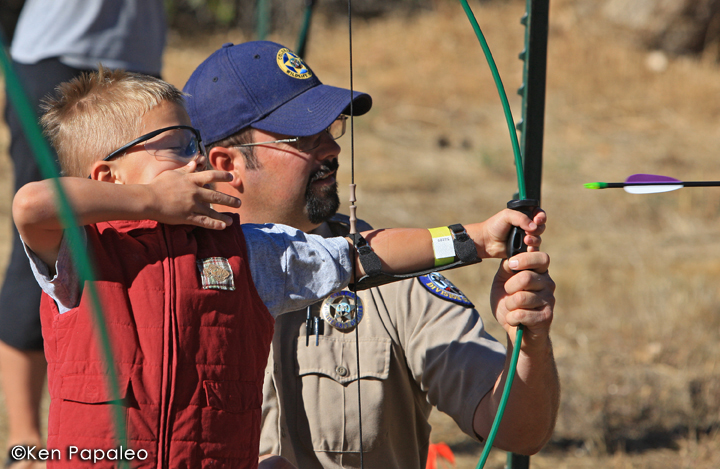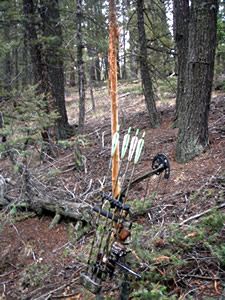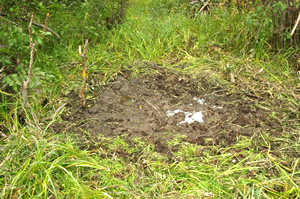Hunting Up Close -Archery Elk Hunting
For most of us, hunting is a life-long pursuit. We have developed (over the years) a routine that begins every year around the first of February and, in one way or another, finds us in the Colorado high country in late August, early September. It seems second nature to expect big game brochures to arrive in the mailbox, an "alarm clock" announcing the new hunting season. After a few planning sessions with our hunting partners we decide on hunt units and species. Sometime before the April deadline we apply for our "tags" and after a month or so of anxious waiting we get draw results off the web. We spend the next 3 months or so scouting our hunting units, usually not as often as we would like (and, at the same time, more often than our better halves would prefer). Two or 3 days before opening weekend we are off to the woods. For the next 4 weeks we are in our element! Sounds great, right? It is. (Not that you need any convincing, but check out Colorado Parks and Wildlife's well-planned and produced hunting videos, especially rocky mountain elk in autumn.
 Not everybody has had enough experience, however, to develop a routine. Whether you are a long-time hunter new to Colorado, an out-of-state guest, or a first-time archery hunter, we sincerely hope this article will help you experience the true wonder of early season hunting in the state that hosts the largest heard of elk in the world! Archery hunting can be the most exhilarating experience a sportsperson can imagine. The absence of city noise, the hubbub of modern life, the relaxed attitude of animals that haven't been hunted all year, and the usually mild weather make for an unforgettable good time.
Not everybody has had enough experience, however, to develop a routine. Whether you are a long-time hunter new to Colorado, an out-of-state guest, or a first-time archery hunter, we sincerely hope this article will help you experience the true wonder of early season hunting in the state that hosts the largest heard of elk in the world! Archery hunting can be the most exhilarating experience a sportsperson can imagine. The absence of city noise, the hubbub of modern life, the relaxed attitude of animals that haven't been hunted all year, and the usually mild weather make for an unforgettable good time.
For the sake of this article we will assume that you have used the previous Elk Hunting University articles to decide upon hunt units and have applied for and drawn your particular elk tag choice. You have pre-planned a few weekends to scout, you found your bow in the basement, dusted off your hunting pack, and now the time has come—start counting down the days!
As the summer progresses and you spend time looking for elk, you might spot a herd that is not a part of the unit you will be hunting. Take note, you might want to apply for that area next season.
During the dog-days of summer your pre-hunting activities are kicked into high gear. Final scouting trips should be planned, and your maps marked. Target practice is very important at this point, and by now you should be hitting in groups of 4 inches to maximum 6 inches at 30 yards. If you plan on using an elk call, you should be comfortable with it; please don't practice on elk while sitting in your car at the side of the road—elk learn fast! (Find a Range:
Shooting Range List)
Spend some time looking at the
Game Management Unit interactive maps. The Elk Migration and Travel Corridors map shows you where to focus efforts and mark GPS points.
As the hunt draws near, spend time in the forest (not necessarily where you'll hunt) and practice making tough up-hill, and down-hill shots (check forest regulations first). It's also a good time to judge distances before pulling out the range finder to verify your guess. Review your hunt plan. Use
Plan Your Hunt as a checklist.
When it comes time to start packing for a hunt, start a couple weeks early to check gear before it's packed and loaded into the camper. The camper is used as a base camp (which can easily be substituted with a tent). For this article’s “hunt”, we did not take into consideration the use of any Off-Highway Vehicles (OHV) or horses.
Making a list and checking it off is helpful; try making a list of all the gear you take and separate it into two categories—gear for a backpack hunt, and gear for a base camp or static hunt from a fixed tent. If you decide to use a base camp, you can then configure your pack with essential gear you need to carry and know what weight you are carrying. Knowing weights of items beforehand comes in handy when planning to carry a backpack! Packaged goods are unwrapped and sealed in plastic bags that can be reused for hauling trash back out. Conserving weight by carrying items that serve more than one purpose is a good practice; the multi-purpose tool, for example. It has a saw blade that will get you by in the back-country to cut branches for firewood, elk pelvis, and ribs, and a sharp blade that can take care of an elk. Don't forget to bring extra coolers—a quartered elk will fill two king-sized (really big!) coolers.
No matter how well you plan, you can count on one thing: the elk have complete disregard of your plan. Be flexible. No secret here—elk are where you find them, sometimes hunting from base camp will keep you in elk range. But you may have to follow the herd. Having a backpack ready to go might be your best option, planning for more than one scenario both can increase your odds of success. My preference is packing a mid-sized backpack to carry emergency items, along with sufficient supplies to field dress an elk and even having a game bag or two will save an extra trip back to camp.
 Archery season can bring hot days and cold nights; don't be surprised by early snow, rain with lightning, sleet—even all of the above in one day. Dress in layers; most days start off frosty-cold in the morning to mid-day sun in the 80s.
The Art of Survival has great information on items you should carry at all times; the other topics are worth a review, too. Especially important, these days you can carry one of a number of devices that allow you to send messages and/or emergency location signals. The piece of mind is priceless.
Archery season can bring hot days and cold nights; don't be surprised by early snow, rain with lightning, sleet—even all of the above in one day. Dress in layers; most days start off frosty-cold in the morning to mid-day sun in the 80s.
The Art of Survival has great information on items you should carry at all times; the other topics are worth a review, too. Especially important, these days you can carry one of a number of devices that allow you to send messages and/or emergency location signals. The piece of mind is priceless.
Your food supplies are a personal choice, and for day hunts be sure to have nutritional bars and plenty of water. During the archery season you have more daylight hours, which make for a long day in the field. Getting back to camp and cooking a meal and then cleaning up (being bear aware) is a lot of effort. Simple heat-and-serve meals might be considered.
Now it's time to head out to your elk camp, always leaving a map and hunting trip information including: specific information location, arrival, and departure times with someone at home. Pre-arranged call times are a good idea if that can be arranged as well. Before you leave, get a 10-day weather forecast and print it out. Have a list of phone numbers that you can carry in case of emergencies—and don't forget your hunting license. One last check of the bow and a final practice round before the hunt are in order; by now, your confidence in your shooting needs to be high.
It does not matter where you set up your elk camp—bears will be in the area. Once your camp is set, keep it clean and lock coolers and unsealed food items in your vehicle. Read
Backcountry Camping in Black Bear Country.
Once in the field a host of decisions must be made. Should you call to the elk or just move slowly through the woods and hope to intercept them? If you have had time to scout your area extensively you can try to set up on a wallow, water hole, game trail, or elk crossing and wait them out. If your scouting has been limited, spot and stalk may be the ticket. Archery hunters will tell you that all of the tactics listed above work and more often than not it is the correct use of all them that leads to a successful harvest.
First things first—find elk! All of the map making, planning, and practice are of little use if the elk that were in your "secret spot" a month ago are now one drainage away. Hopefully you are able to setup camp early enough before the season opens that you have time to do some last minute scouting. Of course you don't want to go stomping around the woods that you're going to be hunting but you can learn a lot by simply looking and listening.
"Glassing" your hunting area from a high vantage point can gain you invaluable information about elk movement in your hunting area. Elk tend to move up and down the mountains they inhabit early in the morning and also late in the afternoon or early evening. This habit can make it fairly easy to pinpoint travel routes. These routes or trails can be a great place to ambush elk as they move between feeding and bedding areas.
As you sit looking over your area, listen very carefully; elk are the most vocal members of the deer family and, contrary to popular belief, elk communicate back and forth to each other all the time. Bull elk don't have to be in the full swing of the rut to bugle, and the chirps, bleats, and mews of cow and calf elk can be heard year-‘round in the Colorado high country. Elk regularly announce their presence and the hunter who is paying attention can profit from this apparent lack of restraint.
Now that you have current information on movement and location (even if very general) you will want to put together a plan for the morning hunt. Your plan should put you on course to intercept moving elk. Again, elk will move between feeding areas and bedding grounds. Choosing a spot that, from your scouting, shows the most promise of a well-beaten trail, saddle, or a wallow would be ideal. Do what it takes to be not only downwind of the elk, but appropriately up or down hill from them as well. The cool morning air in the valleys and draws of the Colorado mountains tends to move uphill as it warms. As temperatures drop in the afternoon, the cool air that is at the ridge-tops begins to move back down the mountains.
Get into position early—the quickly-fading darkness of early morning will afford freedom of movement without detection that daylight hours will not. The key is not spooking the elk out of your area before you get a chance to hunt them. Use every trip in and out of the woods before and during your hunt as a scouting trip. Be mindful of elk sign.
A good sign that elk are using an area is "rubbed" trees. Look for a smaller aspen trees or pine saplings that bull elk use to rub against to rid their antlers of drying velvet, and to otherwise vent their general frustrations! These trees tend to be stripped of bark 2 to 6 feet from the ground. A bull with a real bad attitude will wipe the tree clean of all branches and bark. Check rubs for "freshness"; newly rubbed trees will still have a softness to their bark and will still be oozing sap.
 Look for wallows. Elk use wallows for several reasons; cooling themselves down in the hot, early days of fall, to control pesky insects, and to spread scent, effectively marking their territory. These small bodies of water can be as large as a back yard pool or as small as a kitchen sink. Evidence of fresh tracks in the mud around a wallow is evidence of recent use. But chocolate milk-colored water and fresh hair prints (made as the elk rolls in the mud) near the edge of the wallow is sure proof that elk are near.
Look for wallows. Elk use wallows for several reasons; cooling themselves down in the hot, early days of fall, to control pesky insects, and to spread scent, effectively marking their territory. These small bodies of water can be as large as a back yard pool or as small as a kitchen sink. Evidence of fresh tracks in the mud around a wallow is evidence of recent use. But chocolate milk-colored water and fresh hair prints (made as the elk rolls in the mud) near the edge of the wallow is sure proof that elk are near.
As the morning passes, listen for the tell tale sounds of elk movement: a twig breaking, rolling rocks, cow calls, or possibly a bugle. Once elk are located it may be necessary to move to the elk or you can try to call them to you. Try a soft cow call, then, if you get a reply, wait a minute and call again. Be patient. It may take some time for the animals to move to you. If your call is not answered, try again just a bit louder. You may even want to try a bugle. Remember, start soft then work louder—don't blow their heads off with your first call!
Calling elk is, for most, a trial and error process; listen to the elk and try to sound like them. Listen for a response. It may take just seconds for a "hot" bull to answer, but it can take several minutes. A bull that doesn't feel that the caller is close enough to be threatening may simply ignore calls. If these attempts fail to produce a response, consider the wind direction and start to move slowly on a course that will put you ahead of the elk. At all times be mindful of animals that may be present but remain quite.
Few things in life prepare a hunter for his or her first up-close experience with one of nature's greatest residents. It's hard to imagine that an animal that can hear a pin drop on a feather pillow, see a gnat blink, and smell an unscented candle from across a football field can be successfully hunted. Perhaps that's why after all the hard work, planning, and practice even the most seasoned hunters often turn to putty when it all comes together. The chest-pounding increase in heart rate and the seemingly instant lack of oxygen that a close encounter causes can make it nearly impossible to hold steady on your quarry. Take a moment to settle yourself. The unbelievable thrill of the moment can quickly sour with an ill placed shot. Shoot like you have practiced, pick a spot, draw smoothly, anchor, peep, pin, trigger, breathe and squeeze.
After you release your arrow you will have one of two feelings—a great sense of accomplishment as the arrow hits the target as you have planned, or great concern that you might not have hit the spot. Mark the spot where you stood at the time the arrow was released, where the elk stood, and the direction the elk ran. Most of the time, what you do after the shot will improve your odds of retrieving your downed elk.
Take some time to savor the moment. Most likely, the release of your arrow is the culmination of a year’s worth of hard work. Enjoy it! Allow 30 to 45 minutes before beginning your recovery efforts. Generally, big game will travel down-hill, and rarely in a straight line. Pay attention to every detail, place markers often. If you lose track, circle your last best sign. Tracking after the shot can be the hardest part of your hunt so be patient and listen—a wounded elk will hold up in the thickest cover you can imagine.
For an archer, every harvest is a trophy and the memory is better shared with good field photo. Spend a few minutes preparing the animal for the trophy photo; clean up excess blood. If the tongue is hanging out, take pictures from the other side or tuck it in. Look at hunting magazines for good examples of clean trophy photos.
Archery hunting has a relatively low success rate. As with any method of hunting, more times than not you will head back home without an elk. The experience and the fair chase will keep you coming back!
If you do harvest an elk be aware of the temperature. During the archery season most day time highs are well above 60 degrees. You should quarter the elk and pack the meat in coolers for the trip home. You've worked hard to get to this point; proper care of your prize is critical.
And . . . Congratulations!

